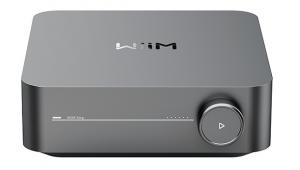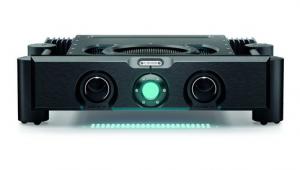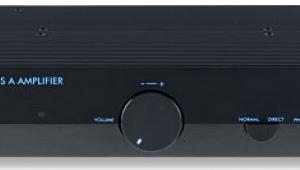Emille Cha'am (£8450)
Hats off to the industrial designers at Emillé Labs. As with all the company’s reassuringly expensive tube amplifiers, the curiously named Cha’am integrated is a masterpiece of industrial design and it looks a million dollars.
You can be forgiven if you’ve assumed the company is French. In fact, Emillé hails from South Korea, and is a specialist audio division of Kwangwoo Electronics [see ‘The Name Rings a Bell’ box-out]. While established as a high-end marque nearly 20 years ago, it’s only more recently that Emillé has branched out with distribution in the western territories of Europe and the USA.
Just try lifting this amplifier! At 44kg it’s a seriously hefty bit of kit, mainly due to its substantial transformers of course, while it weighs no less than 72kg when delivered in its handsome wooden packing crate. It has an extraordinarily large footprint too, which inevitably raises the question, ‘Where to put it?’ Accommodating the Cha’am in your system will require some consideration, as the majority of equipment racks won’t even come close to taking its bulk. As it offers remote control one supposes it wouldn’t be out of the question to site it on the floor. Indeed, Emillé manufactures an elegant matching ‘plinth’ for the Cha’am (and other models in its range) fabricated in aluminium and Plexiglass – but if you’d like one you’ll need to budget a further £795.
The amp is a dual mono design employing for each channel a 6922/6DJ8 triode followed by a 6350 phase inverter and two 6350 tubes for the driver stage. The output stage comprises a pair of 6500s while bias meters and adjustment pots are provided to permit individual trimming of bias current – a nice touch for ‘tube rollers’ who like to experiment with different makes of valves.
Emillé Labs claims a wide frequency response thanks to its hand-crafted output transformers that are made in-house, while within its chassis the Cha’am employs gold-plated glass epoxy circuit boards with 2oz copper tracks. Internal wiring is silver-plated, along with silver contact relays employed throughout. The motorised volume control is via a Japanese Alps ‘Blue Velvet’ potentiometer, brief ‘stabs’ on the handset buttons allowing reasonably precise adjustment of volume.
TAKING ON THE BEST
As Ken Kessler pointed out in our recent group test of budget-priced valve integrated amplifiers [HFN May ’10], myriad manufacturers of affordable tube amplifiers from the Pacific Rim have been largely responsible for the valve breed’s continued popularity among today’s audio enthusiasts, especially among hobbyists keen to explore the differences in tonality available by experimenting with various makes of valves.
Emillé Labs however can be viewed more as challengers to established western manufacturers of thermionic esoterica such as Audio Research, McIntosh, conrad-johnson and the UK’s EAR-Yoshino. The company’s amplifiers exude opulence and display a skilful combination of modern sculpture and retro styling, their immaculately finished anodised aluminium chassis and Plexiglas cover plates creating a most striking visual impression.
Emillé’s top-flight KI-120 monoblock power amps will set you back a cool £25,000 per pair, however the company also has some more affordable integrated models in its range including the KI-40L rated at 40W/8ohm (£5760) and 70W KI-270 (£7150) that appears almost identical to this latest Cha’am model. However, what the Cha’am adds is remote control operation via a simple aluminium handset with straightforward volume up/down and mute buttons, plus a transformer-coupled balanced input that employs Swedish-made Lundahl transformers.
BALANCING ACT
The opportunity to audition the Cha’am coincided with my playing host to Aspara Acoustic’s substantial HL1 horn speakers that graced the front cover of our May issue. The timing was propitious, as the combination worked particularly well, delivering a vibrant, engaging sound with a noticeably free-flowing quality that was highly musical.
Substituting my resident Mark Levinson No.383 solid-state integrated amplifier with the Cha’am proved beyond doubt that the exquisite beauty of this Emillé model is more than skin deep. It also proved that one should never judge a book by its cover – or, in this instance, by the topology of its circuit design. While the sound of the Cha’am appeared effortless and relaxing to listen to, this was not achieved by delivering a soft, syrupy-smooth balance. In fact the sound was detailed and explicit, with plenty of high frequency sparkle that created a feeling of air and space and a delightful three-dimensionality to the soundstage with good recordings.
The string bass on Diana Krall’s ‘My Love Is’ from 1997’s Love Scenes [Impulse IMP12342] sounded rich and resonant, while the halo of reverberation around Diana’s voice was highly resolved. The percussive clicks were crisp and fast, with a lightness of touch that helped deliver a bouncy, spirited presentation with vivid clarity.
The amp sounded mighty powerful too, delivering high sound pressure levels when the occasion demanded. Listening to the grandiose ‘Waiting For The Big One’ from a Japanese pressing of Peter Gabriel’s eponymous first solo LP [Poystar/Charisma 20S-100] the Cha’am produced a cavernous soundstage of aircraft hangar proportions, while guitarist Steve Hunter’s get-down-and-dirty guitar chops possessed urgency and not a little anger. The sound was both resonant and explosive with headroom to spare, with tremendous presence and atmosphere and no sense of stridency despite the sharp clarity.
Similarly the cold, icy European synthesised sound of The Eurythmics was presented with uncommon civility. The title track from 1983’s Sweet Dreams album [RCA 71471] was delivered devoid of any unpleasant grain, edge, or stridency despite the ‘thin’ electronic treatments on Annie Lennox’s vocals that can all too easily become hard and brittle. Again, the Cha’am managed this without in any way sounding soft and rolled off. The track’s electronic percussion was crisp and sharply-etched while the synthesizer riffs displayed a vivid disposition that buoyed musical lines along with infectious pace.
KNIGHT'S CHALLENGE
Switching to my towering Townshend Sir Galahad loudspeakers it was still apparent that the Cha’am has the ability to float a large three-dimensional soundstage with delicious transparency of midrange and high frequency details. What the amplifier doesn’t resolve – when your loudspeakers have the ability to plumb the very lowest bass registers – is bass texture and detail in abundance.
With the Dallas Symphony Orchestra’s 1967 recording for Vox/Turnabout of Rachmaninoff’s ‘Symphonic Dances For Orchestra’ [remastered at 24-bit/96kHz; Classic Records DVD, DAD 1004] the spatial cues of this famous recording were beautifully resolved and, again, the sound was fast and vibrant. The rasping brass and crashing percussion appeared highly explicit, the Emillé’s vivid balance marrying most satisfactorily with the speaker’s lines of ribbon tweeters that err towards smooth sweetness rather than crystalline liveliness. The recording is known to be uncompromising with a vibrant tonal balance, yet the Cha’am’s liquid midrange quality helped avoid ‘glare’ while the lucidity of its treble created an exceptional sense of occasion.
FREE OF FATIGUE
In comparison to my Levinson No.383 integrated, which is uncommonly smooth-sounding, the treble again was a bit more lit up. Yet this appeared not to be in the range that’s responsible for any fatiguing hardness, but rather higher to make the sound appear fresh and open. Where the midrange and vibrant treble detail spotlighted the Cha’am’s virtues, the bass was less explicit, falling off in ultimate weight and dynamics in the context of this set-up when the orchestra’s tympani truly let rip with gusto.
Staying with high resolution source material and playing the DVD-Audio reissue of Foreigner’s Foreigner 4 album [Atlantic/Rhino 8122743669] which contains a couple of ‘almost unplugged’ bonus tracks – modern studio recordings that are explosively dynamic – the Emillé once again sounded sparklingly open and fresh. But when asked to deliver chunky blocks of powerful bass it lacked clarity and definition in the very low registers. Yes, it sounded satisfyingly weighty and powerful, but it became a little sluggish and failed to articulate the true character and textural tones of the pumping bass lines in ‘Juke Box Hero’. Nor did the bass extend as deeply as it might when listening to this set through Aspara’s HL1 horns with their considerable 12in woofers.
When playing within its comfort zone the Cha’am remains poised and articulate. It’s informative of recording quality without sounding clinically analytical, while its easy-going nature kept whetting my musical appetite late into the evenings.
VERDICT
Emillé Labs’ Cha’am integrated is undeniably expensive, but construction quality is exquisite and its immaculate fit and finish assures pride of ownership. While it doesn’t deliver the bass ‘slam’ that owners of large speaker systems might desire for listening to rock music, it nevertheless combines fine detail resolution with a delightful easy-on-the-ear quality. Auditioning with your chosen speakers is mandatory.
Sound Quality: 78%


























































